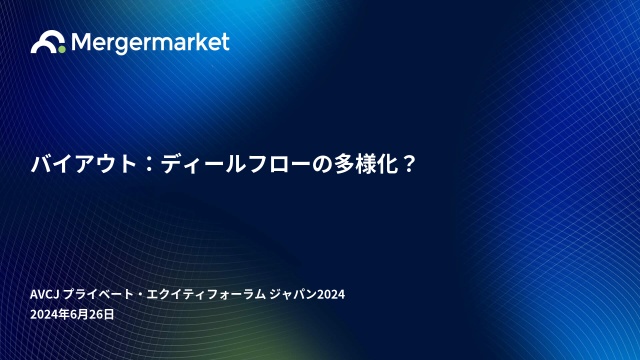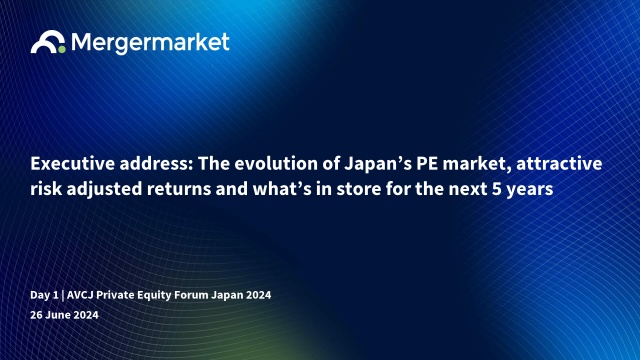Agenda
Registration and refreshments
Global outlook: Time to move
Private equity is caught in a bind. On one hand, a slowdown in exits has contributed to a challenging fundraising environment. On the other, deployment is patchy and dry powder is at record levels. Managers must adapt to these conditions by identifying new sources of capital, ensuring transactions are structured for resilience, establishing differentiated value creation strategies, and being more thoughtful and targeted about exits. Our panellists discuss how to navigate internal and external obstacles.
- To what extent are market conditions in 2024 different to 2023?
- Where are the most attractive pockets of opportunity globally?
- What characteristics set managers apart from their peers?
- Can creative approaches to liquidity generation kickstart fundraising?
Networking break
Sponsored by
Japan update: Right here, right now
Japan confounded prevailing industry trends in 2023: it was the only major Asian market to see year-on-year increases in fundraising and exits, while investment reached an all-time high. Policy support, helpful regulatory reforms, a weak yen, and key structural factors driving deal flow all count in Japan’s favour as an investment destination. This has attracted more capital as global GPs and LPs prioritise Asia’s developed markets. Our panellists consider how long the music will last.
- Will more challenging economic conditions rein in the market?
- What is the appeal of Japan for LPs relative to other jurisdictions?
- Are fund sizes at risk of becoming too large for the opportunity set?
- How are managers developing their value creation capabilities?
Mid-market: Into the engine room
Ten years ago, Japan was seeking about 50 private equity buyouts per annum. The total surpassed 80 in 2016 and 120 in 2022. While deals of USD 500m-plus have grown in number – from one handful to two handfuls – the middle market still dominates. The diet of succession planning transactions sprinkled with corporate carve-outs has fuelled robust returns, leading to increased competition as large-cap players intermittently step down in size. Our middle-market experts assess the landscape.
- Does the middle market offer the best value for money in Japan?
- How are managers enhancing deal sourcing and talent development issues?
- Why does the middle market offer a long term investment opportunity for LPs and will sponsor-to-sponsor transactions become a significant part of the market?
- What are ways in which GPs are differentiating themselves and will there be more spin-out GPs as the local industry matures?
Lunch
Buyouts: More diversified deal flow?
Are take-private transactions set to become a significant – and sustainable – source of deal flow in Japan alongside founder-succession deals and corporate carve-outs? With regulators asking companies that trade below book value to consider their strategic options, more management teams have initiated talks with private equity about delisting. The development underscores increasing acceptance of buyout solutions in Japan, but GPs must still be mindful of how they manage processes and present their value creation theses.
- What are the primary risk factors in public-to-private processes?
- How is the leveraged finance market in Japan evolving?
- Is increased competition leading to unsustainably high valuations?
- How are GPs addressing the complexities of ever-larger corporate carve-outs?
LP viewpoint: Identifying sources of alpha
Portfolio maturity, strategic objectives, the denominator effect, the impact of a weak yen on US dollar-denominated budgets – all these factors influence how Japanese institutional investors approach alternatives in the current market environment. Finding the right balance is difficult. A natural bias towards defensive and diversified portfolios might be unsettled by notions that accessing outperformance amid uncertainty requires a degree of opportunism across different asset classes. Our experienced LP panel discusses approaches to asset allocation.
- How are reduced distributions impacting allocation decisions?
- What role are secondaries and co-investment playing in portfolios?
- Which geographies are most likely to generate the best returns?
- How are LPs approaching currency hedging?
Japan venture capital: Hello world
The ambition coursing through Japanese venture capital is captured in the government’s start-up development plan. A 10x increase in investment is targeted for the five years through 2027, which will enable the creation of 100,000 start-ups and 100 unicorns. It is an increasingly international story as well, with incentives offered to overseas VCs that invest alongside local peers and Japanese start-ups moving quickly to establish global footprints. Investors foreign and domestic map out the future.
- Do start-ups need additional support, and if so, what form should it take?
- Incentives aside, what makes global VCs want to invest in Japan?
- Which segments of Japan’s technology sector are most suited to global expansion?
- What are the most likely exit routes for investors?
Networking drinks
Agenda
Japan Private Equity in 2024 – is this time different?
Japan became the largest regional private equity market in APAC in 2023 at 30% of APAC deal value (vs. 5-10% historically). Deal value hit an all-time high of JPY 5.9T, nearly 2x more than the high-water marks set in 2022 and 2023. These headline growth numbers are as strong as in the first boom of Private Equity in Japan before the global financial crisis, prompting the question: Is this time different?
Bain’s presentation explores the market’s headroom for growth, the momentum of the tailwinds it enjoys today, but also some of the challenges the market may face in the coming years. In the last year, the tailwind of corporate governance improvements received new momentum with TSE’s focus on PBR and capital efficiency. Updates to the M&A code are enabling unsolicited bids and emphasize “market checks” on bids that can provide PE an entry into corporate M&A deal processes. As interest in China wanes, funding aimed at Japan is increasing. In-market investors that capitalize on this interest by growing their fund size must be mindful of the implications: their target universe shrinks, and they may encounter different competitors as they chase larger deals. New-to-market investors that are attracted by Japan Private Equity’s success must be mindful what it really takes to succeed. For all investors, the shifts in competition strengthen the imperative for a very pro-active approach to value creation.
Asia spotlight: Relight the fire
Asian private equity endured a difficult 2023, with substantial drop-offs in fundraising, investment, and exits. China, traditionally the region’s largest market, is unappetising or out-of-bounds for many investors amid concerns about geopolitics and weaker economic prospects. It’s not all bad news. South East Asia has emerged as a fast growing sub region to help with diversification and India’s growth and scale are viewed as a counterpoint to China. DPI is front of mind for investors, and GPs and LPs are having to be resourceful to generate distributions whether that is via secondaries, continuation vehicles or other liquidity solutions. Our panellists discuss where to find the best risk-return and how to access the market whether that is via a regional or country fund.
- How do you make the case for Asia, given performance has trailed other regions?
- What are the best ways to access Asia’s long-term growth story?
- Why aren’t there more sector specialist GPs in the region?
- Is it time to take a contrarian view on China?
Private credit: A popular play
Private credit has become a must-have asset class. Not only can investors leverage longstanding trends connected to the withdrawal of banks from traditional lending, but a higher interest rate environment means they get paid more in the process. LPs have plenty to choose from in terms of risk-return dynamics. However, the lingering question is whether GPs have what it takes to manage positions should macro conditions deteriorate. Our experienced credit investors consider the opportunity set.
- How are macro trends shaping investment opportunities?
- Which private credit strategies currently offer the best risk-return?
- What happens if there is an uptick in defaults by borrowers?
- Where on credit spectrum have Japanese LPs traditionally liked to play?
Activist investors: Disruptive influence
Japan has seen a surge in activist investor campaigns in recent years, spurred by a combination of government policies pushing for better capital efficiency among domestic corporates and more breakthroughs at the board level. High-profile international investors are increasingly looking at the market. For private equity, there are positive and negative consequences. While activists could encourage divestments, they may equally stymy take-private processes by agitating for higher prices. Our market experts assess the activist impact.
- In what ways are governance and regulatory pressure driving the activist agenda?
- How can private equity take advantage of investor activism?
- What can be learned from recent campaigns, both successes and failures?
- Are activist investors approaching Japan differently to other markets?
International LP spotlight: Next stop Japan
While managers across Asia are wary about returning to market, a slew of Japanese fundraises have come in oversubscribed and above target. LPs are being cut back or turned away, even as funds increase in size from previous vintages. For international investors looking for Japan expose, it’s not just a matter of access but finding partners that are a good fit for the perceived market sweet spot. LPs explain how they navigate a hot geography.
- To what extent is Japan the attractive Asia investment destination for international LPs?
- Are Japanese private equity firms becoming too big, too fast?
- What more could be done to facilitate LP co-investment?
- How do Japan’s returns stack up globally and within Asia?
Lunch
Close of conference
Confirm cancellation
An error occurred trying to play the stream. Please reload the page and try again.
CloseSign-up to join the ION Analytics Community to:
- Register for events
- Access market insights
- Download reports


 play_arrow
play_arrow


 play_arrow
play_arrow




 play_arrow
play_arrow






 play_arrow
play_arrow

 play_arrow
play_arrow





 play_arrow
play_arrow




 play_arrow
play_arrow

 play_arrow
play_arrow





 play_arrow
play_arrow






 play_arrow
play_arrow



 play_arrow
play_arrow





 play_arrow
play_arrow





 play_arrow
play_arrow





 play_arrow
play_arrow




 play_arrow
play_arrow























































